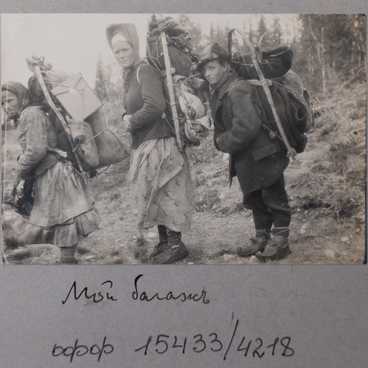Scheme of Sami stamps
In the mid-17th century there were still remnants of the family cult among the Lapps (the cult of ancestors, the cult of the dead, the cult of domestic spirits).
The writers of the 17th century described family priests that still existed. In fact, it was the head of the family — the clan — in the role of a priest. In the Sami settlements there were several clans that had their own ancestors. The Sami also knew very well which clan other Sami belonged to. Each clan had its own nickname. Often the word “aya” (“father, grandfather, ancestor”) was added to the nickname. Many Sami believed that their ancestors were Noids.
The surnames of the Sami of Ekostrovsky settlement are the Kunvyanins, Kobelevs, Chorny, Arkhipovs, Konkovs.
The custom of calling each other by patronymic should also be attributed to the signs of the former clan union. This was not always done and not to everyone, only to the most honorable (elderly and wealthy people). But when they received a guest, they always called him or her by the first name and patronymic.
Sometimes not only the name of the father but also the name of the grandfather was added to the person’s name. When addressing a respected person, one called first the grandfather’s name, then the father’s and finally the name of the person being addressed. For example: Karp-Uvan-Vask (grandfather’s name, father’s name, name of the person addressed). Sometimes the name of the great-grandfather was also added to the names of children: Karp-Uvan-Vask-Uvanash. If a child was raised by his mother, he or she would be called as follows: Marf-akash-Romanash (“Roman of grandmother Marfa”).
The Swedes, Norwegians, and Danes added the word ‘son’ or ‘sen’ (son) to the name: Aslak Aslakson Sara (first name, patronymic, surname). In villages people did not have a surname: father — Olaf Nilsson, son — Hans Olafsson, grandson — Karl Gunson.
Sami women were called “halves”. Another man’s wife was called by her husband’s name. Young ones — Vask-koab (Vasily’s wife), Uvan-koab (Ivan’s wife), Vuenntre-koab (Andrei’s wife). Older ones — Vask-aka (Vasily’s old woman). But when the Sami addressed a woman directly, they called her by her name and patronymic (honorific form). A girl was called by her father’s name — Vask niit (Vasily’s girl). In person they called her by her first name or by her first name and patronymic. In songs, all characters are called by first name and patronymic.

